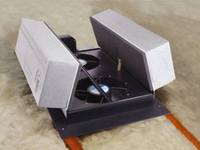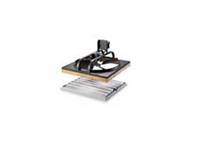Looking for the best whole house fan? What to look out for

Photo by David Segar AOK's
Dear Keith - I live in a two-story colonial, the second floor has trouble cooling down during the summer and I want to install a whole house fan but I am unsure where to start. Any recommendations?
Thanks, Patrick K. Ann Arbor
Summer is right around the corner and now is the best time to solve this annoying issue. Many two-story homes have similar problems due to the Law of Thermodynamics - heat rises. If your home does not have proper ventilation and insulation, it can become uncomfortable when the heat cannot escape properly. Below are a few steps to help resolve your issue.
Whole house fans are designed to bring the outside cooler air into the home by replacing the interior air. The fans, usually installed in the ceiling in the middle of the home, forces the air from the exterior windows into the attic then out the soffit/gable and/or ridge vents. Not only can the fans significantly lower the temperature of your home when used properly, but also they can lower your utility bills compared with using the air conditioning.
There are two main types of whole house fans: unvented ceiling mounted fans and ducted fans. The benefits of the ceiling mounted fans are they typically are less expensive and easier to install. However the ducted fans can be quieter and normally have several inlets instead of one central inlet. Because the most popular ceiling fans are ceiling mounted, I've compiled a few notes to help you in your search for the best fan.
There are several considerations when choosing the right fan.
1. Choose the fan with the right power. Normally, you want to exchange the air in your home every three to four minutes. Each fan is measured by Cubic Feet per Minute (CFM). To figure your home cubic feet, multiply each rooms ceiling height by the length and width for the total cubic feet of air. The ideal fan CFM is the total cubic feet divided by 3 or 4. For example, a typical 1,200-square-foot home would need a fan capable of moving 2,400 to 3,200 CFM.
2. Choose the location, but be sure not to install the fan in a bedroom. Most fans are installed in a central hallway allowing the air to circulate throughout the entire home. The fans' location will be based on aesthetics and functionality. Check your attic to ensure the area is clear and has electrical access.
3. Be aware of possible energy loss. You are installing a big hole in your ceiling and air can escape easily. During the winter you must keep the heat in and vice versa in the summer. Purchase an attic fan cover to help prevent the air from escaping. Most covers are sold separately and installed on the ceiling or inside the attic.
While it may sound a challenging to install, most fans are relatively simple providing the electrical has been prepared. Many fans are self-insulated and a few are designed to fit in between the ceiling joists without modification.
A couple ceiling fans that I recommend are:

Tammark HV1600
Photo by tamtech.com
Tammark HV1600. At $750-$850 and 1600cfm. Although a bit pricey, they have several benefits. The fans are easier to install, have a remote control and have a self-insulation cover included. They are designed to fit in between attic joists for easy installation. The fan settings are remotely controlled and equipped with an automatic insulated R38 cover. Although the fans are a bit quieter, they are less powerful than most conventional whole house fans. Many like the look of the ceiling vent cover because they do not have the common unsightly louvers.
If you need more power, the Granger 3c375 Belt Driven Whole House fan is a nice choice. At $350-$400, it’s a bit more affordable and much more powerful moving at a high rate of 6900cfm.

Granger 3c375
Photo by grainger.com
Side note: How old is your air conditioner? DTE Energy suggests that if your air conditioner is 12 years or older your may consider replacing with a higher efficiency, ENERGY STAR ® system. Not only will it help lower your energy bills, but also many systems qualify for the $1,500 Federal Tax Credit.
Paul is a State of Michigan Licensed Builder. Paul serves as President and founding member of Nationally franchised HandyPro Handyman Service, servicing Washtenaw, Wayne and Oakland Counties. www.handypro.com. Listen to Paul every Saturday at 11:00am on “It’s Your Home, Let’s Talk About It” WAAM Talk 1600AM. Email questions or comments to kpaul@handypro.com


Comments
J Johnson
Fri, Jun 3, 2011 : 12:17 p.m.
Hi Keith, Is there a local company in the Ann Arbor area that can act as a "turn key" contractor that can help identify the best fan for our house and then take care of all the installation / electrical wiring issues etc. ? I have called a few heating/cooling companies, including those that handle "energy saving" items, but I haven't found anyone that handles these. I hate having the AC on and we really need to save money on our utility bill, but because we have lost ash trees, we don't have the nice shade trees to help keep the house cool... Thanks in advance. Love listening to you on the radio when I remember to tune in!
Keith A. Paul
Mon, Jun 6, 2011 : 7:37 p.m.
Thanks for the kind words. Unfortunately, I don't know any local company providing the installation of the fan and electrical. If any readers do please post. Here is an internet home improvement referral service that has helped many homeowners match with prescreened contractors. Servicemagic.com I hope this helps.
frank
Tue, Mar 1, 2011 : 12:34 a.m.
Does anyone know why QC Manufacturing is suing Airscape Fans? I own an Airscape Whole House Fan and want to make sure there's nothing I have to worry about. I tried asking Airscape Fans why Quiet Cool Whole House Fans was suing them, but they wouldn't respond to me. Thanks,
Keith A. Paul
Mon, Jun 6, 2011 : 7:27 p.m.
35:271 Patent Infringement
Keith A. Paul
Tue, Jun 1, 2010 : 10:47 a.m.
I've heard good reviews regarding solar powered attic fans except when its cloudy. Keep in mind this will remove the hot air from your attic only and not your entire home, as will a whole house fan. I am not aware of a solar powered whole house fans. Let me know if you find one and Ill help research for you.
julieswhimsies
Fri, May 28, 2010 : 6:34 p.m.
There is a solar-powered ceiling/attic fan out there, as well. I saw it priced at around $500.00. I'm wondering how effective it is.
ed
Fri, May 28, 2010 : 7:47 a.m.
We have had our whole house attic fan for at least 20 years. Haven't noticed any extra dirt being pulled into the house. Great for pulling heat out of the house when canning vegetables from our garden. When in use during the day we pull cool air in from the windows on the shaded side of the house. We have central air but prefer to use it only during times of very high humidity. Our fan is older and doesn't have remote or a timer. One drawback of running it all night is it also draws in the dampness of the night air. It takes a little experimentation to learn how much to open or close each window to equalize the draw from all areas of the house. We could not locate our fan centrally in the house so if the windows nearest the fan are open too wide areas farthest from the fan don't cool as well. After learning how far to open each the fan cools the entire house beautifully
zero2sixty
Thu, May 27, 2010 : 5:55 p.m.
I wasn't familiar with whole house fans until moving into an '80's tri-level 7 yrs. ago. As a tri-level, the basement/family room is open to the rest of the house and has windows at ground level where air pulled in is coolest. The fan is installed on the upper level at the top of the stairs, which branches off to bedrooms and bath. I'm amazed at how well this system works. Turn it on just as the sun is setting & temp. begins to drop outside. The change indoors is noticeable instantly & indoor thermometers begin to drop within 5-10 minutes. The fan works best on a high setting in the evening before bedtime for instant cooling, and turned down to a lower setting at bedtime, with the timer set for a few hours. If it runs all night, there's a good chance someone will have to get up, turn it off & start closing windows because they're cold. If it drops to 60 during the early a.m. hours, that will be the temp. inside your home. A great feature is the timer. It can be set to run from 1-12 hrs. The downside is that mine is noisy. On a high setting, most would have trouble falling asleep if this were located just outside the bedrooms. On a low setting, the hummm of the motor is somewhat calming, drowning outdoor nighttime sounds. My fan is an older Sears model, although I have no idea how old. I've beleived this to be more energy-efficient than running the central air, but the fan is very strong & might use lots of electricity. To use only the fan without central air back-up, the house should be closed up 1st thing in the morning, with shades & blinds drawn to hold the cool air in for the day.
Ignatz
Thu, May 27, 2010 : 1:44 p.m.
Keith, Thanks for the filter info. I'm glad someone found a niche in the marketplace!
Mitch
Thu, May 27, 2010 : 9:46 a.m.
the company is Tamarack Technologies. An though your screens become dirty. It does not work that good at filtering, the dust does land on the insulation though.
Ignatz
Thu, May 27, 2010 : 7:17 a.m.
Years ago, when taking classes on cooling and heating, the instructor made a comment about whole house fans. He told us that while it does make the home cooler, it turns your house into the neighborhood air filter. Get ready to deal with a dirtier house, especially the screens.